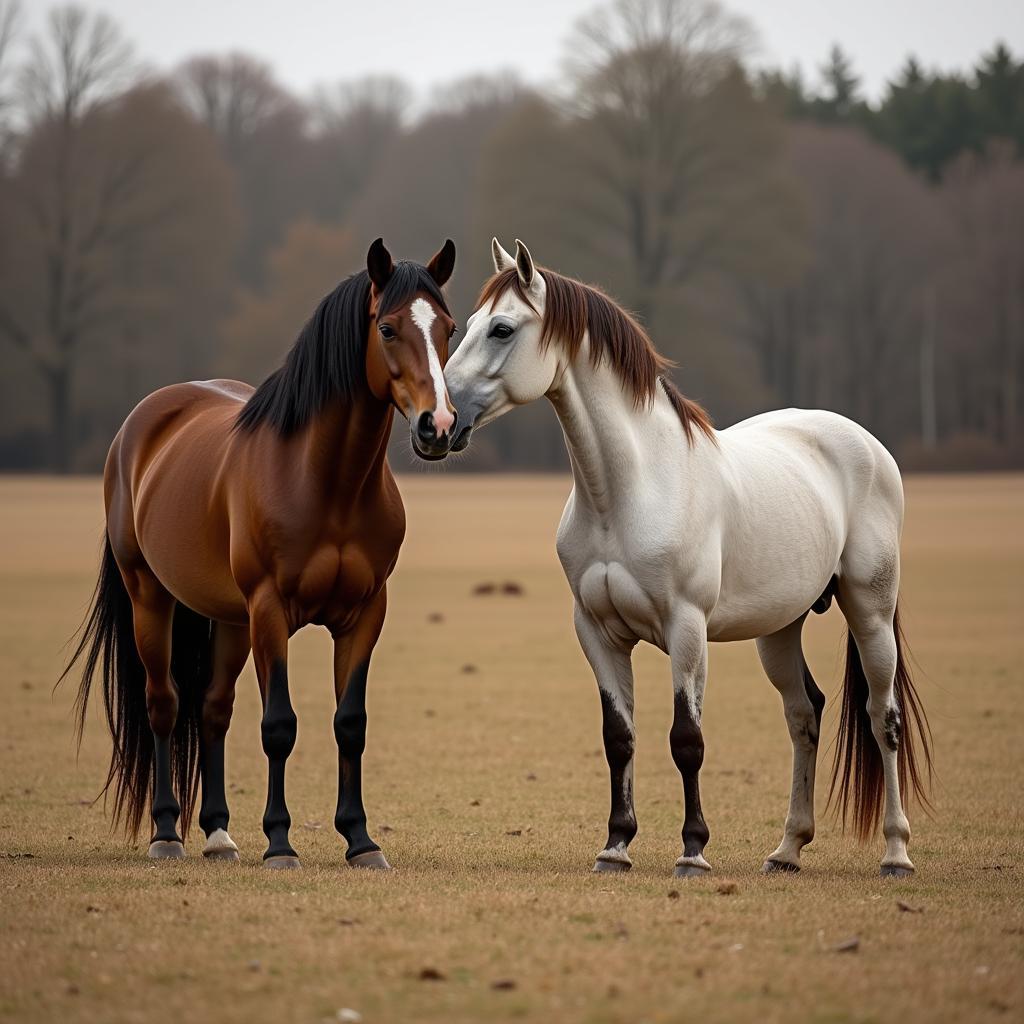Horse Sex With Female horses, also known as mares, is a complex process driven by natural instincts and hormonal cycles. Understanding these intricacies is crucial for responsible horse ownership, especially for breeders. This article delves into the reproductive biology of mares and the natural mating process in horses.
The Mare’s Reproductive Cycle
The mare’s reproductive cycle is seasonally polyestrous, meaning they experience multiple estrus cycles, or “heat” periods, during the breeding season, typically from spring to autumn. Each cycle lasts approximately 21 days, with estrus lasting 5-7 days. During estrus, the mare displays behavioral and physical signs indicating her receptiveness to the stallion. These signs can include increased urination, tail raising, winking of the vulva (clitoral flashing), and a general interest in stallions. Understanding these signs is essential for successful breeding. More information on horse reproduction can be found on our page about horses having sex with horses.
After ovulation, the mare enters diestrus, a period of non-receptivity. If pregnancy occurs, the diestrus phase continues. If not, the mare will return to estrus after approximately two weeks. Managing the mare’s cycle is a critical aspect of horse breeding. A deeper understanding of horse terminology can be helpful, and you can find a glossary of horse terms to know on our website.
Natural Mating Behavior in Horses
In the wild, stallions establish dominance hierarchies within their herds, and the dominant stallion has exclusive breeding rights to the mares within his band. When a mare is in estrus, she will signal her receptivity to the stallion through various behaviors. The stallion will respond by courting the mare, which involves sniffing, nuzzling, and nipping. This courtship behavior further stimulates the mare and prepares her for mating. The actual mating process, also referred to as “covering,” is relatively brief but can be quite vigorous.
 Stallion Courting Mare
Stallion Courting Mare
The stallion mounts the mare from behind, guided by her signals. Successful mating results in the deposition of sperm into the mare’s reproductive tract. Observing these natural behaviors can provide valuable insights into horse reproduction. You can learn more about the specifics of horse and donkey sex on our dedicated page.
Factors Affecting Horse Breeding
Several factors influence the success of horse breeding, including the mare’s age, health, and nutritional status. The stallion’s fertility and the timing of breeding are also crucial. Breeding too early or too late in the mare’s estrus cycle can reduce the chances of conception. Additionally, environmental factors, such as temperature and daylight hours, can influence the mare’s reproductive cycle. For more specific information on this topic, check out our article on sex with horse female.
How to Determine if a Mare is in Estrus
Accurately identifying when a mare is in estrus is crucial for successful breeding. Besides observing behavioral changes, such as those mentioned earlier, veterinarians can perform several tests, including rectal palpation and ultrasound, to assess the mare’s reproductive tract and confirm ovulation.
“Understanding the mare’s subtle cues and hormonal cycles is the key to successful and ethical breeding practices,” says Dr. Emily Carter, DVM, a renowned equine reproductive specialist.
The Role of the Veterinarian in Horse Breeding
Veterinarians play a critical role in ensuring the health and well-being of both the mare and stallion throughout the breeding process. They can provide guidance on breeding management, perform necessary reproductive examinations, and address any potential complications that may arise.
“Regular veterinary checkups are crucial for maintaining the reproductive health of your horses and ensuring successful breeding outcomes,” adds Dr. Carter.
Conclusion
Understanding horse sex with female horses is essential for responsible horse ownership and breeding. By recognizing the mare’s reproductive cycle and natural mating behaviors, breeders can increase the chances of successful conception and ensure the well-being of their animals. Remember, consulting with a veterinarian is crucial for managing the breeding process effectively and addressing any potential health concerns. If you have further questions about this topic, we encourage you to explore our article on baby horse crossword clue for more information.
FAQ
- How long is a mare’s estrus cycle? (Approximately 21 days)
- How long does estrus last in mares? (5-7 days)
- What are some signs that a mare is in estrus? (Increased urination, tail raising, winking of the vulva, interest in stallions)
- What is the role of a veterinarian in horse breeding? (Breeding management, reproductive examinations, addressing complications)
- When is the breeding season for horses? (Typically spring to autumn)
- How can I learn more about horse terminology? (Visit our page on horse terms to know)
- What are some factors that affect horse breeding? (Mare’s age, health, nutrition, stallion’s fertility, timing of breeding, environmental factors)
For any assistance, please contact us at Phone Number: 0772127271, Email: [email protected] Or visit us at QGM2+WX2, Vị Trung, Vị Thuỷ, Hậu Giang, Việt Nam. We have a 24/7 customer service team.